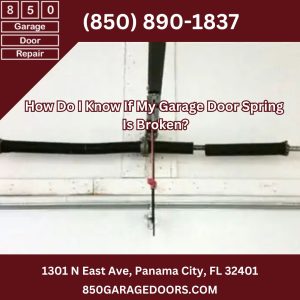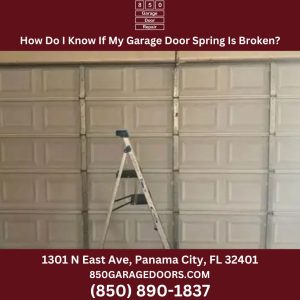
Common Signs of a Broken Garage Door Spring
The Door Feels Extremely Heavy or Won’t Open
If your garage door feels much heavier than usual or refuses to open, the spring may no longer be providing the necessary counterbalance. This is often one of the first and most obvious signs of a broken spring.
You Hear a Loud Bang From the Garage
When a spring breaks, it can release a significant amount of tension, often creating a loud bang similar to a gunshot. If you hear this noise coming from your garage, it’s wise to inspect your door before attempting to use it again.
The Garage Door Opens Crooked or Uneven
A broken spring may cause the garage door to lift unevenly or appear crooked as it moves. This is particularly noticeable with extension springs, which help balance the door from both sides.
The Door Only Opens a Few Inches Then Stops
Most automatic garage door openers have a safety feature that stops operation if the door is too heavy to lift. If your door starts to open but stops after a few inches, it’s a strong indication the spring is broken.
Visible Gap or Separation in the Spring
Look closely at the spring mounted above your garage door. If you see a visible gap, break, or separation in the coils, the spring is broken and needs immediate attention from a professional.
Why Do Garage Door Springs Break?
Normal Wear and Tear From Daily Use
Garage door springs are rated for a certain number of cycles — each cycle being one opening and closing of the door. Over time, the constant tension and release wear down the metal, eventually causing failure.
Rust or Corrosion on the Spring
In humid environments like Florida, moisture can cause rust or corrosion on the metal springs. Rust weakens the coils and can accelerate breakage if not addressed through regular maintenance.
Lack of Regular Maintenance and Lubrication
Without proper lubrication, the metal-on-metal friction wears out springs faster. Regular maintenance helps extend the life of the springs and prevents premature failure.
Torsion Spring vs. Extension Spring — How to Spot the Difference
Where They Are Located on Your Garage Door
Torsion springs are mounted above the garage door on a metal shaft, while extension springs are found on either side of the door, stretching along the horizontal tracks.
How They Break and What Signs to Look For
Torsion springs typically snap in place, leaving a visible gap. Extension springs often break at the ends, causing a loose cable or an unbalanced door. Recognizing which type you have can help you understand the specific signs of failure.
What to Do If You Suspect a Broken Spring
Stop Using the Garage Door Immediately
Attempting to use a garage door with a broken spring can cause further damage to the opener or tracks and may create a safety hazard. Stop operation and secure the area until a professional can inspect it.
Call a Professional for Inspection and Repair
Garage door springs are under high tension and attempting DIY repairs can be extremely dangerous. Always contact a licensed technician who has the right tools and expertise to replace or repair the spring safely.
The Dangers of DIY Garage Door Spring Repairs
Replacing or repairing a garage door spring is not a DIY project. The springs hold a tremendous amount of tension, and mishandling them can lead to serious injury. Professional technicians follow strict safety protocols to handle spring repairs properly. It’s best to leave this job to experienced service providers to avoid unnecessary risks.
How to Prevent Garage Door Spring Failure in the Future
Schedule Regular Professional Maintenance
Routine maintenance checks by a professional can identify worn springs before they break. This helps you avoid unexpected malfunctions and ensures safe operation.
Keep Springs Lubricated and Rust-Free
Applying a high-quality garage door lubricant to the springs can minimize friction and prevent rust buildup, especially in coastal or humid areas.
Replace Springs in Pairs to Maintain Balance
When one spring breaks, the other is usually not far behind. Replacing both at the same time helps maintain even balance and prolongs the life of your garage door system.
| Warning Sign | Possible Cause | Recommended Action |
|---|---|---|
| Heavy Door | Broken or worn spring | Stop use and call a technician |
| Loud Bang | Spring snapping under tension | Inspect visually and seek professional help |
| Uneven Door Movement | Extension spring failure | Do not operate, call for service |
| Door Stops Mid-Operation | Spring not supporting weight | Contact a professional immediately |
| Visible Gap in Spring | Spring snapped | Replace with the help of a technician |
 Final Thoughts — Don’t Ignore the Warning Signs
Final Thoughts — Don’t Ignore the Warning Signs
Garage door springs are vital to the safe and smooth operation of your door. If you notice any of the signs mentioned, it’s important to take action quickly. Ignoring the problem can lead to further damage or even accidents. By recognizing the warning signs, maintaining your door properly, and relying on trusted professionals, you can ensure your garage door continues to serve your home reliably. If you suspect a broken spring, reach out to the experts at 850 Garage Doors for professional service and peace of mind.

